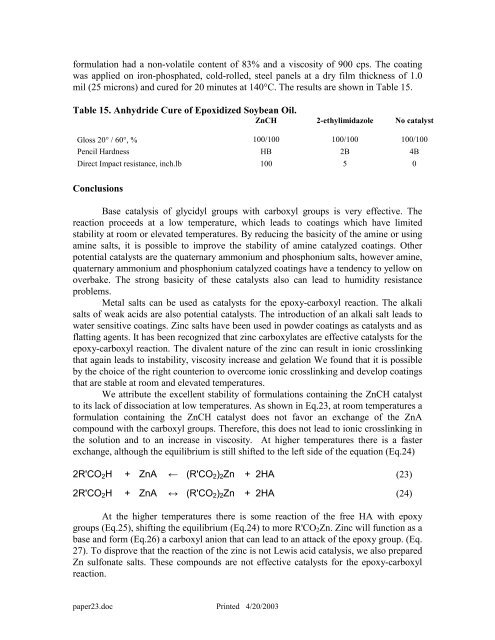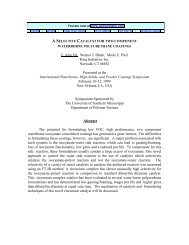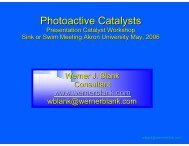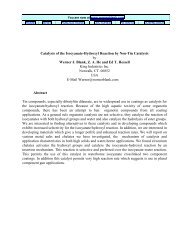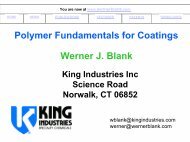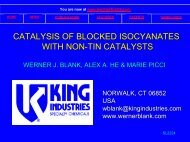Catalysis of the Epoxy-Carboxyl Reaction - Werner Blank
Catalysis of the Epoxy-Carboxyl Reaction - Werner Blank
Catalysis of the Epoxy-Carboxyl Reaction - Werner Blank
You also want an ePaper? Increase the reach of your titles
YUMPU automatically turns print PDFs into web optimized ePapers that Google loves.
formulation had a non-volatile content <strong>of</strong> 83% and a viscosity <strong>of</strong> 900 cps. The coating<br />
was applied on iron-phosphated, cold-rolled, steel panels at a dry film thickness <strong>of</strong> 1.0<br />
mil (25 microns) and cured for 20 minutes at 140°C. The results are shown in Table 15.<br />
Table 15. Anhydride Cure <strong>of</strong> Epoxidized Soybean Oil.<br />
ZnCH 2-ethylimidazole No catalyst<br />
Gloss 20° / 60°, % 100/100 100/100 100/100<br />
Pencil Hardness HB 2B 4B<br />
Direct Impact resistance, inch.lb 100 5 0<br />
Conclusions<br />
Base catalysis <strong>of</strong> glycidyl groups with carboxyl groups is very effective. The<br />
reaction proceeds at a low temperature, which leads to coatings which have limited<br />
stability at room or elevated temperatures. By reducing <strong>the</strong> basicity <strong>of</strong> <strong>the</strong> amine or using<br />
amine salts, it is possible to improve <strong>the</strong> stability <strong>of</strong> amine catalyzed coatings. O<strong>the</strong>r<br />
potential catalysts are <strong>the</strong> quaternary ammonium and phosphonium salts, however amine,<br />
quaternary ammonium and phosphonium catalyzed coatings have a tendency to yellow on<br />
overbake. The strong basicity <strong>of</strong> <strong>the</strong>se catalysts also can lead to humidity resistance<br />
problems.<br />
Metal salts can be used as catalysts for <strong>the</strong> epoxy-carboxyl reaction. The alkali<br />
salts <strong>of</strong> weak acids are also potential catalysts. The introduction <strong>of</strong> an alkali salt leads to<br />
water sensitive coatings. Zinc salts have been used in powder coatings as catalysts and as<br />
flatting agents. It has been recognized that zinc carboxylates are effective catalysts for <strong>the</strong><br />
epoxy-carboxyl reaction. The divalent nature <strong>of</strong> <strong>the</strong> zinc can result in ionic crosslinking<br />
that again leads to instability, viscosity increase and gelation We found that it is possible<br />
by <strong>the</strong> choice <strong>of</strong> <strong>the</strong> right counterion to overcome ionic crosslinking and develop coatings<br />
that are stable at room and elevated temperatures.<br />
We attribute <strong>the</strong> excellent stability <strong>of</strong> formulations containing <strong>the</strong> ZnCH catalyst<br />
to its lack <strong>of</strong> dissociation at low temperatures. As shown in Eq.23, at room temperatures a<br />
formulation containing <strong>the</strong> ZnCH catalyst does not favor an exchange <strong>of</strong> <strong>the</strong> ZnA<br />
compound with <strong>the</strong> carboxyl groups. Therefore, this does not lead to ionic crosslinking in<br />
<strong>the</strong> solution and to an increase in viscosity. At higher temperatures <strong>the</strong>re is a faster<br />
exchange, although <strong>the</strong> equilibrium is still shifted to <strong>the</strong> left side <strong>of</strong> <strong>the</strong> equation (Eq.24)<br />
2R'CO2H + ZnA ← (R'CO2)2Zn + 2HA (23)<br />
2R'CO2H + ZnA ↔ (R'CO2)2Zn + 2HA (24)<br />
At <strong>the</strong> higher temperatures <strong>the</strong>re is some reaction <strong>of</strong> <strong>the</strong> free HA with epoxy<br />
groups (Eq.25), shifting <strong>the</strong> equilibrium (Eq.24) to more R'CO2Zn. Zinc will function as a<br />
base and form (Eq.26) a carboxyl anion that can lead to an attack <strong>of</strong> <strong>the</strong> epoxy group. (Eq.<br />
27). To disprove that <strong>the</strong> reaction <strong>of</strong> <strong>the</strong> zinc is not Lewis acid catalysis, we also prepared<br />
Zn sulfonate salts. These compounds are not effective catalysts for <strong>the</strong> epoxy-carboxyl<br />
reaction.<br />
paper23.doc Printed 4/20/2003


